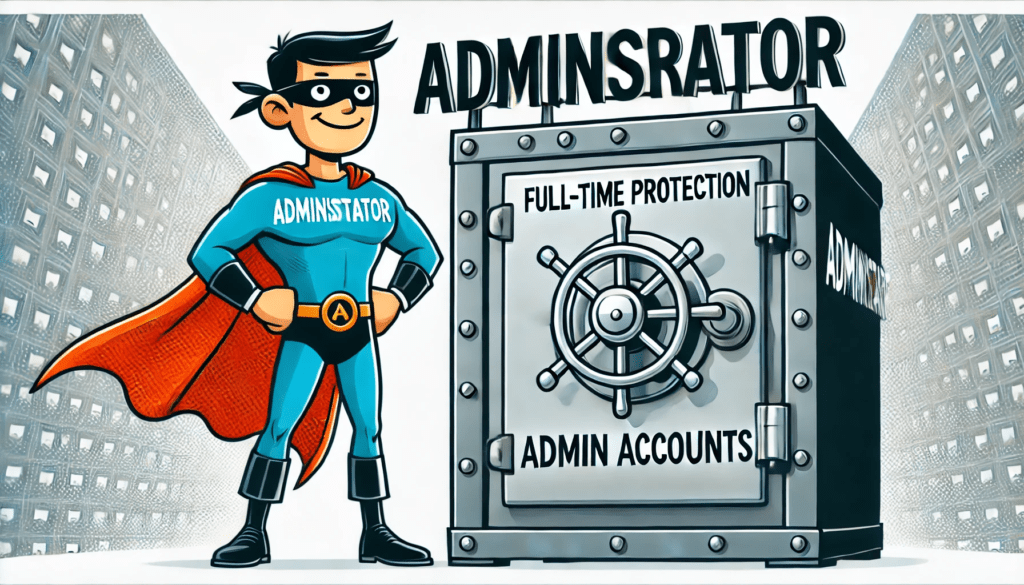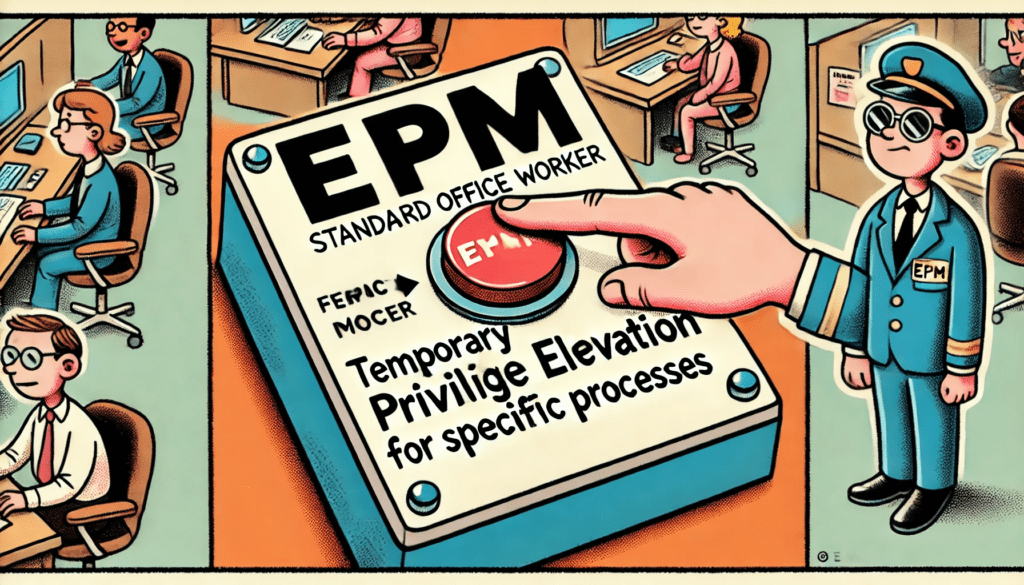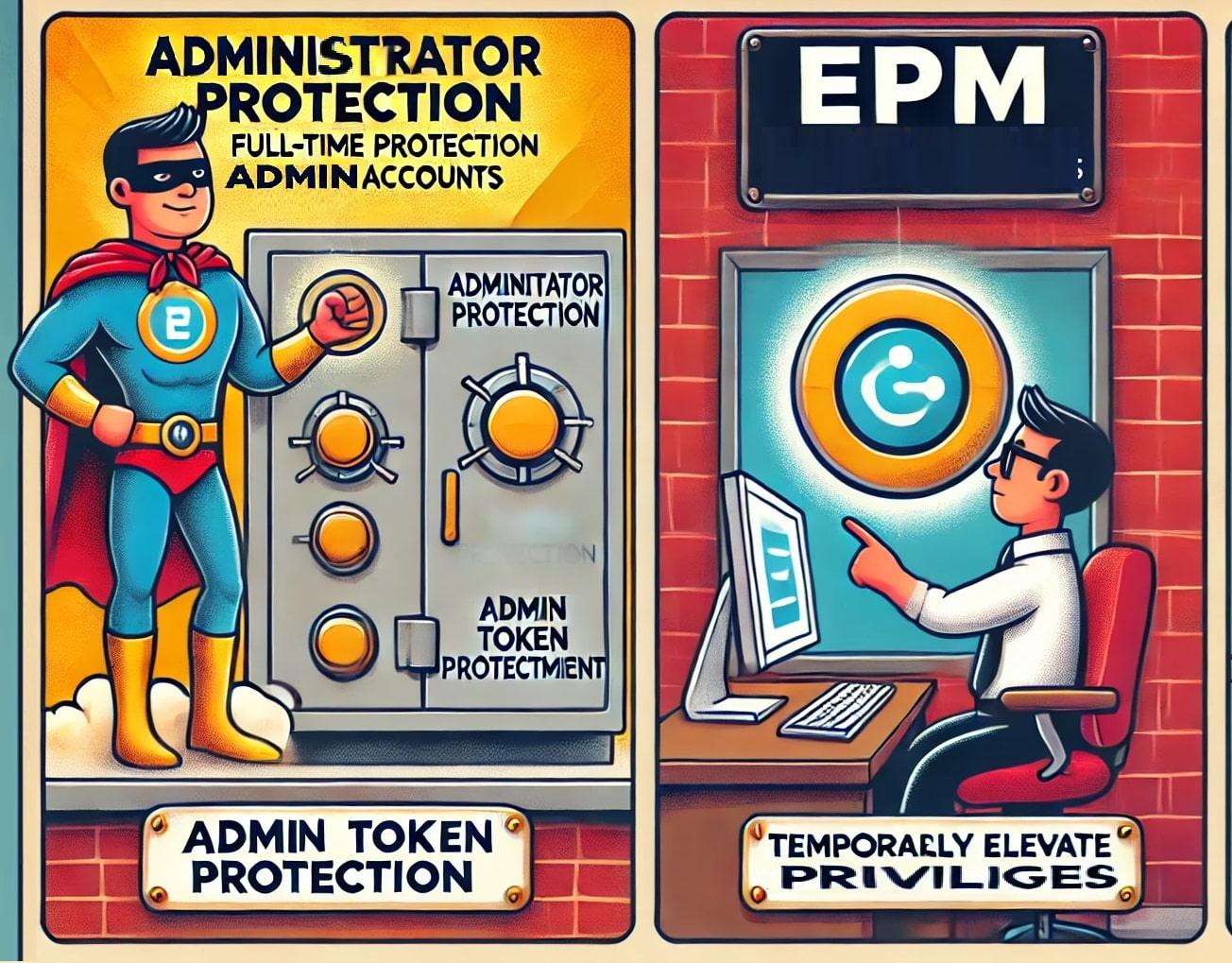After posting the blog about Administrator Protection, one question kept coming up: What are the key differences between Local Administrator Protection vs EPM (Endpoint Privilege Management)? Some even wondered if EPM is being replaced now that Administrator Protection is here. Let’s clear things up!
While both features focus on managing administrative privileges, they serve very distinct purposes. Let’s explore what each one does and why both are essential.
Administrator Protection: Safeguarding Admin Accounts from Token Theft
Administrator Protection in Windows 11 focuses on securing the admin account you log in with, making it an excellent tool for developers and system administrators who frequently need to use those admin credentials
One of the biggest security concerns with those admin accounts is token theft. When users are logged in as administrators, attackers can potentially steal the admin token. This digital credential grants elevated access, which attackers can use to run malicious operations without the user’s knowledge.

To mitigate this, Administrator Protection introduces a hidden admin account, like “Clark Kent mode.” This hidden identity (admin token) stays dormant and is only activated when an action requires elevation. Once the elevated task is completed, the admin profile locks itself again, protecting the token from unauthorized access. By keeping the admin token concealed and limiting its exposure, Administrator Protection significantly reduces the risk of token theft and enhances security.
Endpoint Privilege Management (EPM): Elevating Standard Users
Microsoft Endpoint Privilege Management (EPM), on the other hand, focuses on standard users who need temporary elevated permissions for specific tasks without granting them full-time admin rights. EPM allows standard users to elevate their privileges in a controlled manner based on policies set by administrators, ensuring they only gain the permissions needed for the task at hand, like installing software or making system changes, while still operating under a standard user account for the rest of their work.

This approach is particularly valuable in environments where minimizing permanent admin access is crucial, but users still need flexibility to perform tasks requiring higher privileges.
Administrator Protection vs EPM: Use Cases and Focus
Here’s a breakdown of the primary difference between Administrator Protection and EPM:
- Administrator Protection is focused on protecting the managed admin account from threats like token theft. It ensures that administrative privileges are only accessible when required and locks them down when not in use, making it much harder for malicious actors to exploit elevated access.
- EPM is designed for standard users who occasionally need elevated privileges to complete specific tasks. It provides temporary, controlled admin access without permanently elevating the user’s account, thereby minimizing security risks while maintaining productivity.
Comparing the Approaches
Both Administrator Protection and EPM use just-in-time principles and similar underlying technologies to manage privileges, but they apply these technologies in different ways:
- Administrator Protection is designed to safeguard administrators by securing the admin token, which remains hidden and protected. The token only unlocks when necessary, allowing for admin rights during specific tasks, and is immediately secured again afterward. This process reduces the risk of token theft since elevated privileges are only available temporarily.
- Endpoint Privilege Management (EPM) empowers standard users by enabling them to elevate specific processes or actions, such as installing apps or changing settings, without granting full-time admin access. This allows users to perform necessary tasks efficiently while minimizing the risks associated with permanent administrator rights.
Virtual Account Isolation: A Common Challenge in Both Approaches
Although Administrator Protection and Endpoint Privilege Management (EPM) serve different purposes, they both rely on the same underlying mechanism: hidden admin (virtual) accounts to manage elevated privileges. This commonality introduces a shared technical challenge: isolated environments.
These hidden admin (virtual) accounts are crucial for security, as they isolate elevated actions from the user’s main profile, reducing the risk of token theft or privilege escalation. However, this isolation also comes with a significant drawback: the elevated processes may not have access to the user’s or administrator’s usual registry settings or file system, which can lead to unexpected failures during tasks.

Admin Account Challenges in Administrator Protection
In Administrator Protection, the admin token is hidden and only activated when an elevation is required. The elevated process runs within a separate, isolated admin profile. Since this profile is disconnected from the admin’s usual environment, any task that depends on user-specific registry settings (like HKCU) or files in the admin’s profile may encounter problems. For example, if a process expects certain licensing data in the user’s registry, it might fail because the isolated profile doesn’t have access to that part of the registry.
EPM and Its Similar Struggles
EPM uses virtual accounts to give standard users temporary administrative privileges for specific tasks, such as installing software or changing system settings. The isolated environment created for this task limits the virtual account’s access to the user’s registry and file system. Just like in Administrator Protection, this isolation can prevent the elevated process from accessing necessary resources, causing the task to fail if it requires user-specific settings or files.
Why We Need Both
To answer the common question: no, EPM isn’t going away. The two features are designed for entirely different use cases and serve distinct purposes.
- Administrator Protection is crucial for safeguarding admin accounts by controlling how and when elevated access is granted, protecting the system from attacks that exploit administrator privileges.
- EPM ensures that standard users can complete tasks requiring elevated access without exposing the system to unnecessary risks by providing limited, controlled elevations of privilege when needed.
Conclusion
Windows 11’s Administrator Protection and Endpoint Privilege Management (EPM) tackle privilege management from different angles, and they complement each other rather than replace one another. EPM is designed to give standard users temporary elevated rights for specific tasks or applications, while Administrator Protection focuses on keeping admin accounts secure by reducing their exposure to potential threats. Administrator Protection offers a more straightforward way to protect privileged accounts at the OS level, while EPM allows for more granular control over user actions within enterprise environments. Both are essential tools, each playing a unique role in enhancing security.


